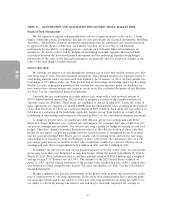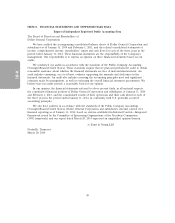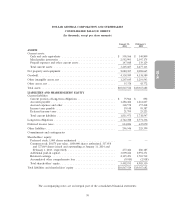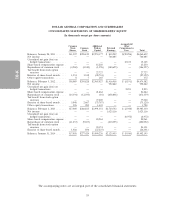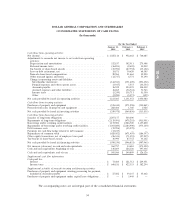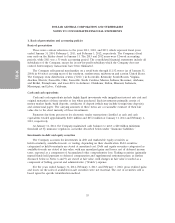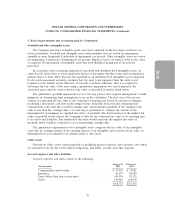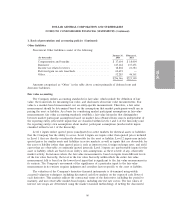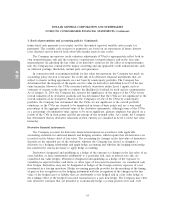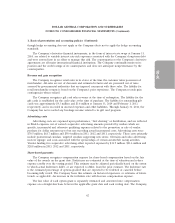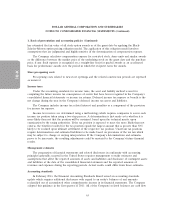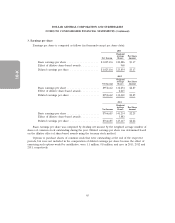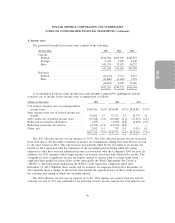Dollar General 2013 Annual Report Download - page 133
Download and view the complete annual report
Please find page 133 of the 2013 Dollar General annual report below. You can navigate through the pages in the report by either clicking on the pages listed below, or by using the keyword search tool below to find specific information within the annual report.
DOLLAR GENERAL CORPORATION AND SUBSIDIARIES
NOTES TO CONSOLIDATED FINANCIAL STATEMENTS (Continued)
1. Basis of presentation and accounting policies (Continued)
Merchandise inventories
Inventories are stated at the lower of cost or market with cost determined using the retail last-in,
first-out (‘‘LIFO’’) method as this method results in a better matching of costs and revenues. Under the
Company’s retail inventory method (‘‘RIM’’), the calculation of gross profit and the resulting valuation
of inventories at cost are computed by applying a calculated cost-to-retail inventory ratio to the retail
value of sales at a department level. The use of the RIM will result in valuing inventories at the lower
of cost or market (‘‘LCM’’) if markdowns are currently taken as a reduction of the retail value of
inventories. Costs directly associated with warehousing and distribution are capitalized into inventory.
The excess of current cost over LIFO cost was approximately $90.9 million and $101.9 million at
January 31, 2014 and February 1, 2013, respectively. Current cost is determined using the RIM on a
first-in, first-out basis. Under the LIFO inventory method, the impacts of rising or falling market price
changes increase or decrease cost of sales (the LIFO provision or benefit). The Company recorded a
LIFO provision (benefit) of $(11.0) million in 2013, $1.4 million in 2012, and $47.7 million in 2011,
which is included in cost of goods sold in the consolidated statements of income.
The Company purchases its merchandise from a wide variety of suppliers. Approximately 8% and
7% of the Company’s purchases in 2013 were made from the Company’s largest and second largest
suppliers, respectively.
Vendor rebates
The Company accounts for all cash consideration received from vendors in accordance with
applicable accounting standards pertaining to such arrangements. Cash consideration received from a
vendor is generally presumed to be a rebate or an allowance and is accounted for as a reduction of
merchandise purchase costs as earned. However, certain specific, incremental and otherwise qualifying
SG&A expenses related to the promotion or sale of vendor products may be offset by cash
consideration received from vendors, in accordance with arrangements such as cooperative advertising,
when earned for dollar amounts up to but not exceeding actual incremental costs.
Prepaid expenses and other current assets
Prepaid expenses and other current assets include prepaid amounts for rent, maintenance, business
licenses, advertising, and insurance, and amounts receivable for certain vendor rebates (primarily those
expected to be collected in cash) and coupons.
Property and equipment
As the result of a merger transaction in 2007, the Company’s property and equipment was
recorded at estimated fair values. Property and equipment acquired subsequent to the merger has been
recorded at cost. The Company records depreciation and amortization on a straight-line basis over the
56
10-K



